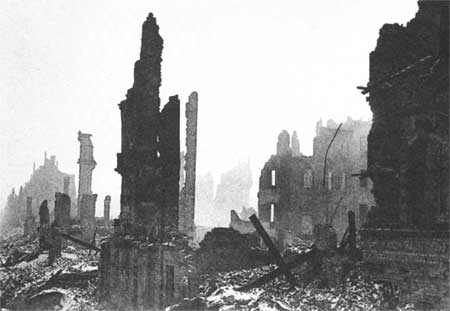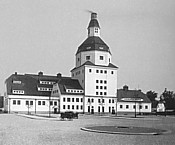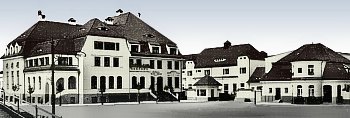|
An Eyewitness to the Holocaust of Dresden Christopher Bollyn
I am truly sad to hear that Kurt Vonnegut has left us. He is one person that I really wanted to meet and now I regret that I didn't.Schlachthof 5 I wound up staying at Dresden's Alter Schlachthof, the old slaughterhouse, quite by accident. On February 14, 2004, exactly 59 years after the Allied fire bombing of Dresden, I took my family to hear the Mozart Requiem at Dresden's Semper Oper and we needed to find an affordable hotel. We grabbed a taxi at the train station and I asked the driver for an inexpensive hotel. He drove about a mile from the town center down a wooded lane and through a large portal in a long wall that ran along the street.
A few hundred feet from the portal stood a small modern hotel, clearly from a later and less grand era, where we took a room. We wound up staying in there for several weeks. The next day I walked around a bit and asked a groundskeeper some questions about what this large complex had been in the past. Eventually I learned that it had been a very famous and scientific modern slaughterhouse designed by Hans Erlwein in the early 1900s. In recent years it had been abandoned and most of the buildings were no longer used. At the main entrance of the complex stood some very impressive buildings,
one of which had the number 5 by the door. That building was the
administration building and at the time that the complex served as a prison
camp, the Allied POWs knew their camp by the post address for this main
building: "Schlachthof 5."
As a 22-year-old POW, Kurt Vonnegut survived the fire-bombing of Dresden because he and the other prisoners had the good fortune to have been kept at the slaughterhouse where they had been taken into the well-built and deep meat cellar. The groundskeeper took me into the cellar so I could see where Vonnegut had survived the holocaust of Dresden.
Vonnegut wrote about how he, as the character Billy, had survived the fire-bombing in Slaughterhouse-Five: Billy was down in the meat locker on the night that Dresden was destroyed. There were sounds like giant footsteps above. Those were sticks of high-explosive bombs. The giants walked and walked. 
Today, the day after Vonnegut passed away at age 84, the BBC played part of an interview with him. He said that he had been an eyewitness to the worst massacre in European history. Vonnegut was under the impression that about 135,000 people had been incinerated in the holocaust of Dresden. This number is at the low end of the death toll estimates from the Ash Wednesday/Valentine's Day holocaust of Dresden. The post-war British and American historians have greatly downplayed the number of victims and the size and viciousness of the Allied war crime that was the incineration – the holocaust of the hundreds of thousands of innocent people and the architectural masterpiece known as Florence on the Elbe. Another eyewitness, the late August Kuklane, had spent time in Dresden looking for his Estonian parents among the hundreds of thousands of refugees that had sought refuge in Dresden during the desperate winter of 1945. Kuklane told me that the number of people estimated to have perished in the city center that had been totally destroyed by fire was about 600,000. Both Vonnegut and Kuklane witnessed American fighter planes strafing the survivors of the holocaust of Dresden: "American fighter planes came in under the smoke to see if anything was moving. They saw Billy and the rest moving down there. The planes sprayed them with machine gun bullets but the bullets missed," Vonnegut wrote.Photo below: after the bombing the Germans burned piles of dead bodies |
 We
passed through the portal and entered into a large complex of well built
but unused buildings that had a massive and most unusual tower structure
in the middle.
We
passed through the portal and entered into a large complex of well built
but unused buildings that had a massive and most unusual tower structure
in the middle.

 I
was surprised to learn that very few people knew that Allied prisoners
had survived the bombing in the meat cellar of the old slaughterhouse and
that one of them, Kurt Vonnegut from Indianapolis, had written a very famous
book about what he had experienced in Dresden – 24 years later.
I
was surprised to learn that very few people knew that Allied prisoners
had survived the bombing in the meat cellar of the old slaughterhouse and
that one of them, Kurt Vonnegut from Indianapolis, had written a very famous
book about what he had experienced in Dresden – 24 years later.